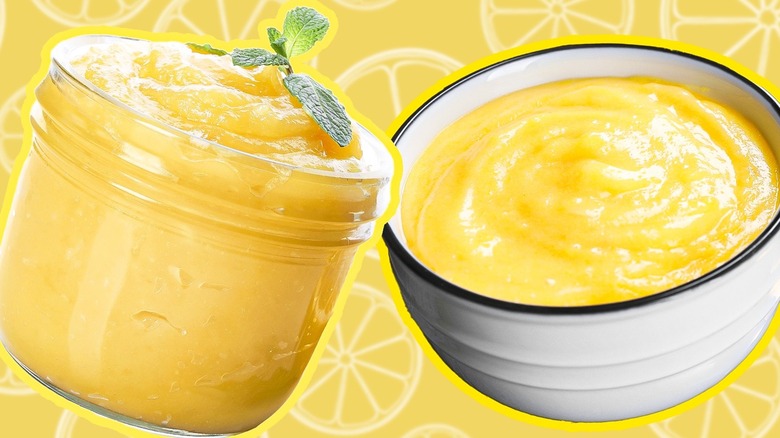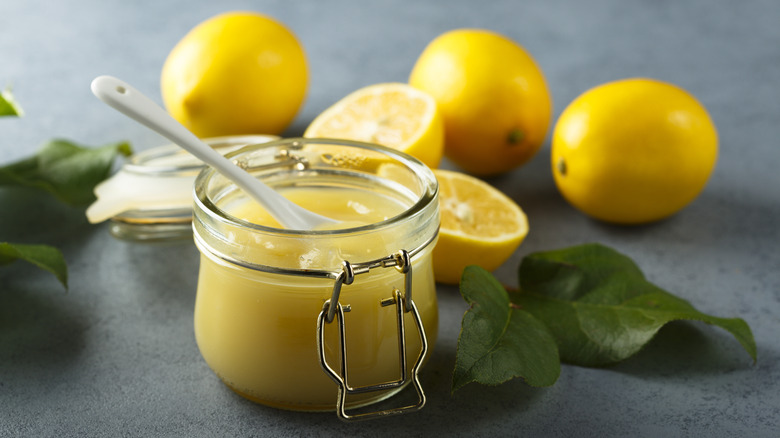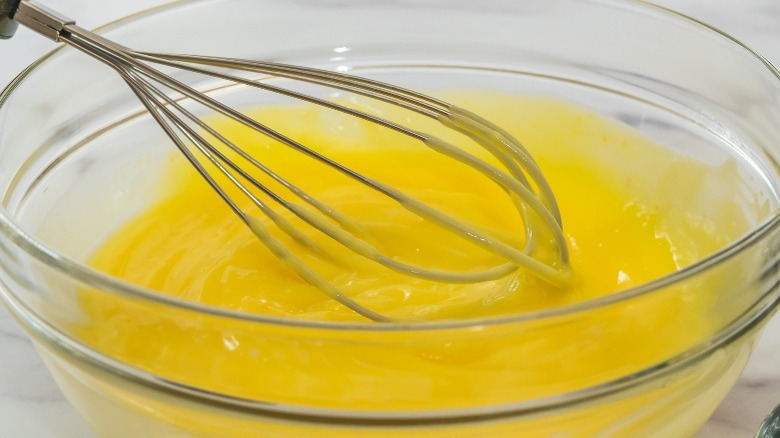The Exact Difference Between Lemon Curd And Pie Filling
The bright, sweet acidity of lemon perks up so many of our favorite desserts, from lemon bars to lemon meringue pie. When you're searching for the right lemony custard to use in a dessert, you'll see some recipes that call for sweet-tart lemon curd — a favorite cooked mixture thickened by gently cooked egg that retains an intense citrus taste. But other pie and pastry recipes use a slightly different combination of nearly the same ingredients to create lemon pie filling, which uses a starch addition to help it hold up better when it's loaded in a crust and sliced for serving.
The recipes for lemon curd and pie fillings may look so similar that you'd be tempted to swap them out, especially if you've had success making one or the other, but the slight shift in thickening methods makes a bigger difference than you might think. Understanding exactly what the result should be will help you know what recipe will lead to the best outcome overall.
What is lemon curd?
Sweet, sticky lemon curd is easy to eat by the spoonful. We love it slathered on scones or heaped on ricotta pancakes as much as we do in its more formal uses in fancy tarts and pastries. With just a small handful of ingredients — lemon juice, sugar, egg yolks, and butter — lemon curd recipes transform acidic lemon juice into just the right balance of sweet and sour. Recipes calling for lemon curd rely on the thickening power of eggs alone for their magic.
Slowly heating egg yolks with acid changes the protein structure of the yolks. The proteins begin to reassemble into the smooth gel-like texture that makes curd so satiny and rich. But eggs can be fickle – a bit too much heat can cause the eggs to scramble, and not enough heat creates a too-soft finished texture. Lemon curd recipes require attention and practice. The good news is that a soft curd can be gently recooked to firm it up, and even an overcooked curd can be strained and enjoyed over fruit or ice cream as a last resort.
What is lemon pie filling?
Lemon meringue pies, lemon-filled doughnuts, and rich cake layered with lemon pie filling to make a summery trifle are all ways you might encounter the thicker, more sturdy version of the cooked lemon pudding we use for filling pies. This combination of lemon juice, sugar, and butter is held together by the addition of a starch, typically cornstarch.
Lemon pie filling needs a firmer structure so that a slice of pie can be successfully cut and served without having the rest of the pie collapse or turn into a sloppy mess on your plate. And although many recipes include egg yolk for both flavor and structure, the real firmness comes from the flavorless cornstarch cooked into the filling.
In the same way that you might use flour to thicken your gravy, pie filling is thickened by the swelling of cornstarch as it's heated in the liquid of the filling. The cooking starch molecules recombine into a mesh that holds the other liquid ingredients firmly. Cornstarch has advantages over other starches like flour or tapioca because it forms a clear gel that allows the yellow lemon juice to stay bright and clear in color.
The thickening agent makes all the difference
Although these two lemony treats rely on sugar, lemon juice, and a bit of butter for their main flavor, the silky textures come from quite different ingredients. Egg yolks add color and flavor to lemon curd, but it's also the critical ingredient for thickening. Egg yolks require a gentle hand with heat to thicken nicely. It might be tempting to add more egg yolk to a lemon curd recipe that doesn't seem to be firming up, but changing the balance of juice to egg will make the flavor unpleasantly eggy. The trick is to be patient, whisking the mixture over low heat until you can draw a clean line through the warm mixture on the back of a spoon.
Thickening pie filling is an easier trick because cornstarch is not as temperamental as egg yolk to heat up. However, it's important to follow your recipe and use the proper amount of cornstarch for the liquid in any recipe to get the correct final thickness — too little will result in a runny mess and too much will be unpleasantly stodgy. With the right amount, you'll get the perfect combination of custard texture and clean-cutting thickness that makes lemon pie filling such a delicious treat.



